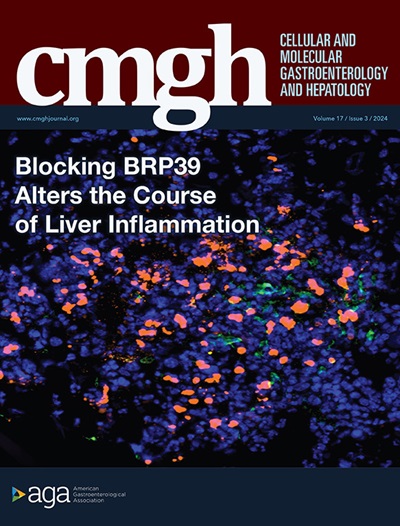Studies of Slc30a10 Deficiency in Mice Reveal That Intestinal Iron Transporters Dmt1 and Ferroportin Transport Manganese
IF 7.1
1区 医学
Q1 GASTROENTEROLOGY & HEPATOLOGY
Cellular and Molecular Gastroenterology and Hepatology
Pub Date : 2025-01-01
DOI:10.1016/j.jcmgh.2025.101489
引用次数: 0
Abstract
Background & Aims
SLC11A2 (DMT1) and SLC40A1 (ferroportin) are essential for dietary iron absorption, but their role in manganese transport is debated. SLC30A10 deficiency causes severe manganese excess due to loss of gastrointestinal manganese excretion. Patients are treated with chelators but also respond to oral iron, suggesting that iron can outcompete manganese for absorption in this disease. Here, we determine if divalent metal transport 1 (Dmt1) and ferroportin can transport manganese using Slc30a10-deficient mice as a model.
Methods
Manganese absorption and levels and other disease parameters were assessed in Slc30a10-/- mice with and without intestinal Dmt1 and ferroportin deficiency using gastric gavage, surgical bile collections, multiple metal assays, and other techniques. The contribution of intestinal Slc30a10 deficiency to ferroportin-dependent manganese absorption was explored by determining if intestinal Slc30a10 deficiency increases manganese absorption in a mouse model of hereditary hemochromatosis, a disease of iron excess due to ferroportin upregulation.
Results
Manganese absorption was increased in Slc30a10-deficient mice despite manganese excess. Intestinal Dmt1 and ferroportin deficiency attenuated manganese absorption and excess in Slc30a10-deficient mice. Intestinal Slc30a10 deficiency increased manganese absorption and levels in the hemochromatosis mouse model.
Conclusions
Aberrant absorption contributes prominently to SLC30A10 deficiency, a disease previously attributed to impaired excretion, and is dependent upon intestinal Dmt1 and ferroportin and exacerbated by loss of intestinal Slc30a10. This work expands our understanding of overlaps between manganese and iron transport and the mechanisms by which the body regulates absorption of 2 nutrients that can share transport pathways. We propose that a reconsideration of the role of Dmt1 and ferroportin in manganese homeostasis is warranted.

对小鼠Slc30a10缺乏的研究表明,肠道铁转运蛋白Dmt1和铁转运蛋白运输锰。
背景和目的:SLC11A2 (DMT1)和SLC40A1(铁转运蛋白)对膳食铁吸收至关重要,但它们在锰运输中的作用尚存争议。SLC30A10缺乏导致严重的锰过量,由于胃肠锰排泄的损失。患者接受螯合剂治疗,但也对口服铁有反应,这表明在这种疾病中,铁可以比锰更容易吸收。在这里,我们以slc30a10缺陷小鼠为模型,确定Dmt1和铁转运蛋白是否可以运输锰。方法:采用胃灌胃、手术取胆、多种金属测定等技术,对有无肠道Dmt1和运铁蛋白缺乏症的Slc30a10-/-小鼠进行锰的吸收、水平和其他疾病参数的评估。在遗传性血色素沉着症小鼠模型中,通过测定肠道Slc30a10缺乏是否会增加锰的吸收,探讨肠道Slc30a10缺乏对铁转运蛋白依赖性锰吸收的贡献。遗传性血色素沉着症是一种由铁转运蛋白上调引起的铁过量疾病。结果:slc30a10缺乏小鼠的锰吸收增加,尽管锰过量。肠道Dmt1和铁转运蛋白缺乏减弱了slc30a10缺乏小鼠对锰的吸收和过量。在血色素沉着症小鼠模型中,肠道Slc30a10缺乏增加了锰的吸收和水平。结论:SLC30A10的异常吸收是SLC30A10缺乏症的重要原因,这是一种以前归因于排泄受损的疾病,依赖于肠道Dmt1和铁转运蛋白,并因肠道SLC30A10的缺失而加剧。这项工作扩大了我们对锰和铁运输之间重叠的理解,以及身体调节两种可以共享运输途径的营养物质吸收的机制。我们建议重新考虑Dmt1和铁转运蛋白在锰稳态中的作用是有必要的。
本文章由计算机程序翻译,如有差异,请以英文原文为准。
求助全文
约1分钟内获得全文
求助全文
来源期刊

Cellular and Molecular Gastroenterology and Hepatology
Medicine-Gastroenterology
CiteScore
13.00
自引率
2.80%
发文量
246
审稿时长
42 days
期刊介绍:
"Cell and Molecular Gastroenterology and Hepatology (CMGH)" is a journal dedicated to advancing the understanding of digestive biology through impactful research that spans the spectrum of normal gastrointestinal, hepatic, and pancreatic functions, as well as their pathologies. The journal's mission is to publish high-quality, hypothesis-driven studies that offer mechanistic novelty and are methodologically robust, covering a wide range of themes in gastroenterology, hepatology, and pancreatology.
CMGH reports on the latest scientific advances in cell biology, immunology, physiology, microbiology, genetics, and neurobiology related to gastrointestinal, hepatobiliary, and pancreatic health and disease. The research published in CMGH is designed to address significant questions in the field, utilizing a variety of experimental approaches, including in vitro models, patient-derived tissues or cells, and animal models. This multifaceted approach enables the journal to contribute to both fundamental discoveries and their translation into clinical applications, ultimately aiming to improve patient care and treatment outcomes in digestive health.
 求助内容:
求助内容: 应助结果提醒方式:
应助结果提醒方式:


